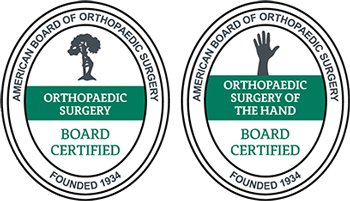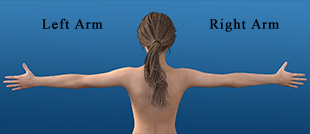What is Trapezium Bone Arthritis?
Trapezium bone arthritis, a common yet often overlooked hand condition, can significantly impact your daily hand function and quality of life. It’s a condition that’s becoming more common, particularly among aging populations. This is often because of wear and tear on the joints over time, repetitive tasks such as typing and texting, and anatomical factors, including the shape of your thumb joint. Trapezium bone arthritis can be extremely limiting as we rely on the thumb for many everyday tasks, such as writing, typing, and buttoning a shirt.
In this article, we explore what trapezium bone arthritis is, what causes it, and what the most common symptoms are. We also take a closer look at how we diagnose the condition at The Hand and Wrist Institute and outline the various potential treatment options that include both surgical and nonsurgical options.
What Is Trapezium Bone Arthritis?
person wearing silver ring with black manicure by orva studio is licensed with Unsplash License
Trapezium bone arthritis, also known as trapeziometacarpal joint arthritis or thumb base arthritis, is a condition that involves the degeneration of the cartilage within the joint at the base of the thumb where the trapezium bone meets the first metacarpal bone. This joint is responsible for thumb movement and function, allowing for tasks such as gripping, pinching, and grasping.
Arthritis in the trapezium bone joint typically develops gradually over time and is more common in individuals over 40, although it can also occur in younger people. The exact cause of trapezium bone arthritis isn’t always clear, but factors such as genetics, prior joint injury or trauma, overuse or repetitive stress on the thumb joint, and certain medical conditions, such as osteoarthritis, can contribute to its development.
Symptoms of Trapezium Bone Arthritis
Here are some of the most common symptoms of trapezium bone arthritis:
- Dull aching pain at the base of the thumb, especially during activities that involve gripping or pinching.
- Swelling, tenderness, and stiffness at the base of the thumb joint.
- Weakness or decreased range of motion in the thumb.
- Thumb pain and stiffness that worsen in the morning.
- A physical bump near the wrist.
- A clicking or grinding sensation within the thumb joint during movement, known as crepitus.
- Difficulty performing tasks that require fine motor skills or thumb movement, such as writing or typing, buttoning clothes, or opening jars.
These symptoms may vary in severity and worsen over time if left untreated. Early recognition and management of trapezium bone arthritis are essential for managing symptoms, maintaining joint function, and improving overall hand function.
Trapezium Bone Arthritis Diagnosis
Our team at The Hand and Wrist Institute starts by assessing your symptoms, including any pain, stiffness, swelling, or weakness in your thumb joint. We may inquire about your medical history, including any previous hand or wrist injuries, and whether you have any underlying conditions such as osteoarthritis or rheumatoid arthritis. During the physical examination, we’ll assess the range of motion of your thumb joint, check for tenderness, swelling, or deformity at the base of the thumb, and evaluate your grip strength and thumb function. We may also perform the grind test (applying pressure to the base of the thumb).
We also use X-rays to diagnose trapezium bone arthritis. X-rays can reveal joint space narrowing, osteophyte (bone spur) formation, and other signs of degeneration. In some cases, we may perform additional imaging studies, such as MRI or an ultrasound, to evaluate the extent of joint damage and assess soft tissue damage. We’ll also consider other conditions that could cause similar symptoms, such as ligament injuries, tendonitis, or other forms of arthritis affecting the thumb joint. By ruling out other potential causes, we can arrive at an accurate diagnosis of trapezium bone arthritis.
Nonsurgical Treatment for Trapezium Bone Arthritis
Surgery may not be required for mild or early stages of trapezium bone arthritis. Here are some of the treatment methods we typically recommend:
- Taking medication: We may prescribe topical medications, over-the-counter pain relief, or prescription pain relief medication to help relieve the pain associated with thumb arthritis.
- Wearing a splint: We may suggest wearing a splint to support your joint and limit movement to reduce pain and rest your joint. This can ensure proper positioning while you work or perform daily tasks.
- Using cortisone injections: If more conservative methods don’t work, we may recommend injecting a long-acting corticosteroid into your thumb joint to provide temporary pain relief and reduce inflammation in the thumb joint.
Surgical Treatments for Trapezium Bone Arthritis
If more conservative methods don’t provide relief or your condition is severe, we may consider surgery as a last resort. All surgeries can be done as an outpatient. After surgery, you’ll need to wear a cast or a splint over your thumb and wrist for up to six weeks. After we remove the splint or cast, you’ll undergo physical therapy to regain strength and movement in your hand and thumb. Here are the options:
- Trapeziectomy: We remove one of the bones in your thumb joint (trapezium).
- Joint fusion (arthrodesis): We fuse the bones in the affected joint. This allows the joint to bear weight without pain but has no flexibility.
- Osteotomy: We reposition the bones in the affected joint to help correct deformities.
- Joint replacement (arthroplasty): We remove all or part of the affected joint and replace it with a graft from one of your tendons.
When To Seek Medical Attention
If you’re experiencing persistent pain, stiffness, swelling, or weakness, particularly at the base of the thumb, we recommend booking an appointment with our orthopedic specialists. If you notice that it’s difficult to perform everyday tasks, such as writing, typing, or holding objects, it may be indicative of underlying joint issues. We can provide a thorough evaluation and diagnosis through a combination of medical history, physical examination, and imaging studies. Early intervention is essential for managing trapezium bone arthritis effectively, as it can help alleviate symptoms, prevent further joint damage, and improve hand function and your quality of life.


























